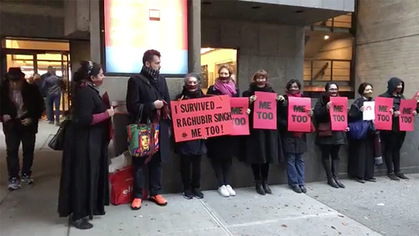
R
E
V N
E
X
T
On a wintry afternoon on December 3, a group of women and men gathered outside the brutalist-style Met Breuer in Manhattan, New York, bearing bright-red signs with two words on them: “ME TOO.” Red gags were handed out, and placed over their mouths, like an ever-present gash that at once signaled resilience, and hinted at the still-raw wounds incurred by sexual abuse. For an hour, from four to five o’clock, an assembly of people stood outside and inside the institution silently; at their center was multidisciplinary artist Jaishri Abichandani, whose sign read: “I survived . . . Raghubir Singh. #MeToo!” Organized by the artist, the protest was a quiet but powerful resistance against gender-based violence, and, more specifically, Abichandani’s own experience of harassment by the late photographer Raghubir Singh, whose work is on view at Met Breuer until January 2.
Abichandani, who was born in Mumbai and now resides in Brooklyn, first brought the case to light on October 13, when she called the attorney and feminist Jill Filipovic on The Brian Lehrer Show, a public radio station produced by WNYC. In the segment, Filipovic and Lehrer spoke to several women about their experiences in light of the downfall of infamous sexual predator Harvey Weinstein. Abichandani revealed that Singh had purchased plane tickets and a hotel room for her in India; as she didn’t have the funds to exit the situation, she had to remain with him for two weeks. Without going into detail about those two weeks, Abichandani revealed her distress regarding the situation, and explained that the abuse continued for one year after that particular incident, up until Singh’s death in 1999. She also mentioned professor Thomas Roma, director of the photography department at Columbia University, as complicit in the verbal abuse that took place, and mentioned that several women contacted her, recalling similar situations with Singh.
Soon after the radio segment, she called for supporters to join her in a public protest, an action supported by South Asian Women’s Creative Collective in New York, which she founded. In her call to action, Abichandani wrote: “My abuser is on display right now, at one of the most prestigious museums in the world, with articles extolling his virtuosity. He may be deceased, but his legacy continues to grow. Help me make his violence visible. Help everyone visualize the scale of the violence by coming and standing with me, physically creating a safe space from which to speak our truths. They can ignore my lone voice, but not a hundred of us.”
Before the protest took place, Sandra Jackson-Dumont, the chairperson of education at The Metropolitan Museum of Art, caught wind of the action and sent the artist an email offering her and the institution’s full support. She clarified, “The Met fully supports the right to free expression and therefore we wish to assure you that we will not try to stop you . . . Let me underscore The Met’s support of your courage to speak out.” Jackson-Dumont also touched upon future programming at the museum, in which they planned to organize an open forum to discuss the role of museums in navigating unexpected revelations about artists or works of art.
The gags were made by Abichandani and photo installation artist Fariba Salma Alam, and the posters by multidisciplinary artist and writer Swati Khurana. Documenta 14 artist Naeem Mohaiemen supported the protest. Social activist Tarana Burke, founder of the Me Too campaign and slogan, which was initiated in the early 2000s, also backed the action remotely. Abichandani is project manager at the Smithsonian Asian Pacific American Center and was the former director of public events at Queens Museum; she recently co-curated the group show “Lucid Dreams and Distant Visions” at the Asia Society Museum in New York, and organized the symposium “Fatal Love: Where Are We Now?” at the Queens Museum and Asia Society.
Ysabelle Cheung is the managing editor of ArtAsiaPacific.
To read more of ArtAsiaPacific’s articles, visit our Digital Library.



